From the early beginning of this review: This book is very recommended and is a invaluable reference for ship modeling. In my opinion a "Must Have"
The Construction and Fitting of the Sailing Man-of-War, 1650-1850 (Conway's History of Sail) (Hardcover)
by Peter Goodwin (Author)
Hardcover: 288 pages
Publisher: Conway Maritime (31 Dec 1997)
Language English
ISBN-10: 0851773265
ISBN-13: 978-0851773261
Product Dimensions: 10 x 11.9 inches
The same book is available also with a slightly different title. My copy which I have in my library is this one
The Construction and Fitting of the English Man of War : 1650-1850 (Hardcover)
by Peter Goodwin (Author)
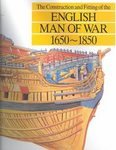
Hardcover: 276 pages
Publisher: Naval Institute Press (Aug 1987)
Language English
ISBN-10: 0870210165
ISBN-13: 978-0870210167
Product Dimensions: 10.5 x 12.2 inches
Synopsis
This title contains a wealth of information on the hull and fittings design and construction of wooden warships.
Every aspect of the building process is covered, including the exact sizes of timber scantlings and fastenings.
Contents
Introduction
Chapter 1 – The Construction of a Ship of War in Frame (page 3 to 38)
The design Criteria
The Keel Assembly
Framing the Ship
The Stern Timbers
The Bow Timbers
After the Framing
Chapter 2 – The Planking of a Ship of War (page 39 to 64)
Internal Planking after 1700
External Hull Planking after 1700
The Deck Planking
The Fastenings
Chapter 3 – Beams, Knees and Internal Stiffening (pages 65 to 110)
The Beams
The Knees
The Internal Stiffening
Chapter 4 – The Construction of the Bulkheads (pages 111 to 128)
The Types of Bulkhead
The Magazines
Chapter 5 – The “Machinery” of the Ship (pages 129 to 164)
The Steering Arrangements
The Ship´s Pump
The Cable Handling Gear
The Drop Keel
The Domestic Arrangements
Chapter 6 – The Internal Fittings (pages 165 to 184)
The Position and Rake of the Masts
The Position and Rake of the Bowsprit
The Masts Partners
Stepping the Mast and Bowsprit
The Riding Bitts
The Manger
The Hawse Holes
Chapter 7 – The External Fittings (page 185 to 204)
The Ship´s Head and the Head Rails
The Lining
Lining
The Fenders
The Channels
Ports
The Gangways
The Catheads
The Quarter Galleries
Chapter 8 – Minor Fittings (pages 205 to 218)
Figurehead, Stern laterns, belfry, hatchways and scuttles, scuppers, skid beams
Hammock stowage, fish davits, boat davits, latrines or “heads”,
ringbolts and eyebolts for gun tackle, shot garlands
Chapter 9 – The Fittings Associated with the Rigging (pages 219 to 224)
Topsail sheet and jeer bitts, kevels staghorns, cavel blocks and cleats,
Timberheads, boomkins
Chapter 10 – Hull Protection (page 225 to 230)
Hull Deterioration
Hull Fastening
Diverse Appendices like Dimensions and scantlings, quantities of timber used, Navy board order,
the 1719 Establishment list, dimension and weight of iron standards
Bilbiography, Index
Review:
This book is an outstanding reference work for anyone desiring detailed information on English warship construction.
It is well detailed illustrated with crisp line drawings and black-and-white photographs of both models and the few preserved period warships still in existence.
It covers every aspect of hull construction, from keel to bulkwark rail, and describes in detail many internal and external fittings.
The book covers hull framing (including the various "systems" devised and used by the Royal Navy during different time periods),
the construction and placement of bulkheads and partitions, and internal furniture such as pumps, capstans, galley, etc.
For example, this is the only known book that discusses the construction and use of the "portable" bulkheads used to partition off cabins on the various gun decks.
Great attention is paid to changes and improvements over the years, along with approximate dates at which these changes became generally accepted.
However, an additional unique aspect of this work is the provision of extensive tables and formulae which allow accurate reconstruction of the dimensions and placement of the many hull components, for a wide range of ship sizes and types.
That makes this book especially valuable to the serious interested of period naval architecture, or the detail interested ship model builder.
Very Good, though general, information about naval architecture of the period.
The title describes the book well.
Important:
The book stop at the decks, anyone interested in rigging details will have to look further in other books. Here f.e. very valuable would be the book "The Masting and Rigging of English Ships of War 1625 - 1860" by James Lees.
A review of this book will follow.
Insight look:
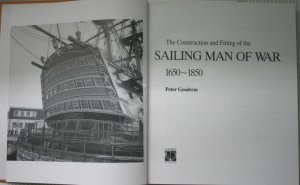
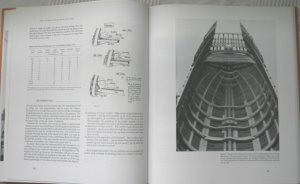

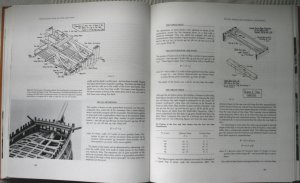
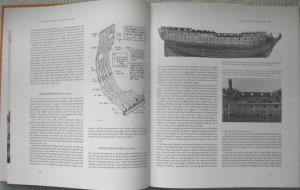
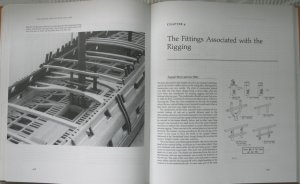
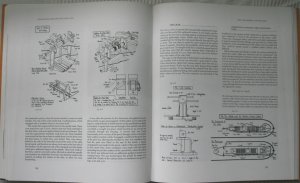


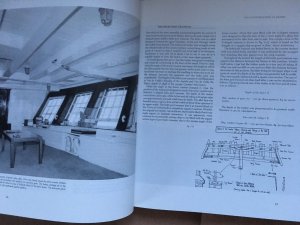
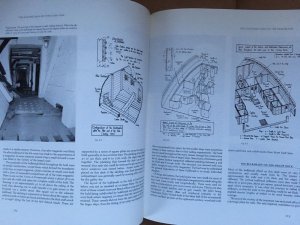
The Construction and Fitting of the Sailing Man-of-War, 1650-1850 (Conway's History of Sail) (Hardcover)
by Peter Goodwin (Author)
Hardcover: 288 pages
Publisher: Conway Maritime (31 Dec 1997)
Language English
ISBN-10: 0851773265
ISBN-13: 978-0851773261
Product Dimensions: 10 x 11.9 inches
The same book is available also with a slightly different title. My copy which I have in my library is this one
The Construction and Fitting of the English Man of War : 1650-1850 (Hardcover)
by Peter Goodwin (Author)

Hardcover: 276 pages
Publisher: Naval Institute Press (Aug 1987)
Language English
ISBN-10: 0870210165
ISBN-13: 978-0870210167
Product Dimensions: 10.5 x 12.2 inches
Synopsis
This title contains a wealth of information on the hull and fittings design and construction of wooden warships.
Every aspect of the building process is covered, including the exact sizes of timber scantlings and fastenings.
Contents
Introduction
Chapter 1 – The Construction of a Ship of War in Frame (page 3 to 38)
The design Criteria
The Keel Assembly
Framing the Ship
The Stern Timbers
The Bow Timbers
After the Framing
Chapter 2 – The Planking of a Ship of War (page 39 to 64)
Internal Planking after 1700
External Hull Planking after 1700
The Deck Planking
The Fastenings
Chapter 3 – Beams, Knees and Internal Stiffening (pages 65 to 110)
The Beams
The Knees
The Internal Stiffening
Chapter 4 – The Construction of the Bulkheads (pages 111 to 128)
The Types of Bulkhead
The Magazines
Chapter 5 – The “Machinery” of the Ship (pages 129 to 164)
The Steering Arrangements
The Ship´s Pump
The Cable Handling Gear
The Drop Keel
The Domestic Arrangements
Chapter 6 – The Internal Fittings (pages 165 to 184)
The Position and Rake of the Masts
The Position and Rake of the Bowsprit
The Masts Partners
Stepping the Mast and Bowsprit
The Riding Bitts
The Manger
The Hawse Holes
Chapter 7 – The External Fittings (page 185 to 204)
The Ship´s Head and the Head Rails
The
 Lining
LiningThe Fenders
The Channels
Ports
The Gangways
The Catheads
The Quarter Galleries
Chapter 8 – Minor Fittings (pages 205 to 218)
Figurehead, Stern laterns, belfry, hatchways and scuttles, scuppers, skid beams
Hammock stowage, fish davits, boat davits, latrines or “heads”,
ringbolts and eyebolts for gun tackle, shot garlands
Chapter 9 – The Fittings Associated with the Rigging (pages 219 to 224)
Topsail sheet and jeer bitts, kevels staghorns, cavel blocks and cleats,
Timberheads, boomkins
Chapter 10 – Hull Protection (page 225 to 230)
Hull Deterioration
Hull Fastening
Diverse Appendices like Dimensions and scantlings, quantities of timber used, Navy board order,
the 1719 Establishment list, dimension and weight of iron standards
Bilbiography, Index
Review:
This book is an outstanding reference work for anyone desiring detailed information on English warship construction.
It is well detailed illustrated with crisp line drawings and black-and-white photographs of both models and the few preserved period warships still in existence.
It covers every aspect of hull construction, from keel to bulkwark rail, and describes in detail many internal and external fittings.
The book covers hull framing (including the various "systems" devised and used by the Royal Navy during different time periods),
the construction and placement of bulkheads and partitions, and internal furniture such as pumps, capstans, galley, etc.
For example, this is the only known book that discusses the construction and use of the "portable" bulkheads used to partition off cabins on the various gun decks.
Great attention is paid to changes and improvements over the years, along with approximate dates at which these changes became generally accepted.
However, an additional unique aspect of this work is the provision of extensive tables and formulae which allow accurate reconstruction of the dimensions and placement of the many hull components, for a wide range of ship sizes and types.
That makes this book especially valuable to the serious interested of period naval architecture, or the detail interested ship model builder.
Very Good, though general, information about naval architecture of the period.
The title describes the book well.
Important:
The book stop at the decks, anyone interested in rigging details will have to look further in other books. Here f.e. very valuable would be the book "The Masting and Rigging of English Ships of War 1625 - 1860" by James Lees.
A review of this book will follow.
Insight look:












